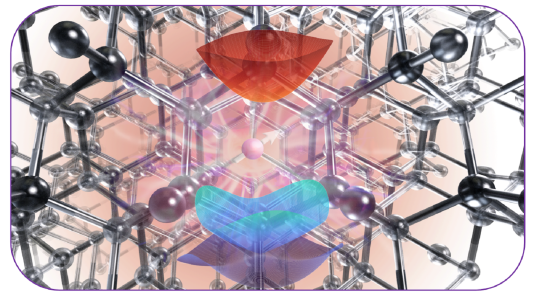A new computational tool has been developed by researchers at the University of Chicago’s Pritzker School of Molecular Engineering, the US Department of Energy’s Argonne National Laboratory, the University of Modena, and Reggio Emilia to describe the behavior of atoms in quantum materials during light absorption and emission.

Ball and stick representation of the atoms in a crystal with a spin defect in the center, and the 3D surfaces (red and blue) showing the excited states of the defect. Image Credit: Peter Allen
The University of Chicago’s Marco Govoni, an Argonne resident associate, is leading a team developing the tool for the Midwest Integrated Center for Computational Materials (MICCoM). The tool will be made available as part of the open-source software package WEST. With the use of this technology, scientists can better comprehend and develop novel materials for quantum technologies.
What we have done is broaden the ability of scientists to study these materials for quantum technologies. We can now study systems and properties that were really not accessible, on a large scale, in the past.
Giulia Galli, Study Senior Author and Liew Family Professor, Molecular Engineering, Pritzker School of Molecular Engineering, University of Chicago
Argonne and Galli have a joint appointment. Galli’s group studied three distinct semiconductor-based materials to demonstrate the accuracy of the tool, called WEST-TDDFT (Without Empty States - Time-Dependent Density Functional Theory), but stated that it could be used with a broad range of related materials. The created software is scalable across several high-performance architectures.
The Building Blocks of Quantum Information
Qubits are the essential building blocks of information that underpin cutting-edge, potent quantum technology. Qubits can exist in states of superposition, representing both zero and one concurrently, in contrast to the bits employed in traditional computing, which can only represent zeros and ones.
Small material flaws, such as an atom that is absent or replaced in a crystal’s ordered lattice, can assume quantum states and be utilized as qubits. These qubits have the potential to be employed as sensors because of their extraordinary sensitivity to the electric, optical, and magnetic characteristics of their environment.
Researchers might be able to better manage these “point defects” or create materials that employ qubits as sensors or data storage devices by having a better understanding of how photons of light interact with them to alter their energy levels.
Galli added, “How these materials are absorbing and emitting light is critical to understanding how they are functioning for quantum applications. Light is how you interrogate these materials.”
Up until now, scientists have been able to anticipate when point defects will absorb or emit light, but they have not been able to completely explain why certain atomic processes occurred inside the material during its excited state, particularly in big and complicated systems.
Streamlining Complex Calculations
To find the atomic characteristics of materials, one must solve extremely complex quantum mechanical equations that demand a lot of processing power. Galli’s team demonstrated in the current study that these equations could still be solved accurately while encoding a new method that was more efficient than the previous one.
The equations are now more easily applied to bigger systems because of their enhanced speed and efficiency of solution. It was previously impractical to examine these systems due to the computational time and power requirements.
With these methods, we can study the interaction of light with materials in systems that are quite large, meaning that these systems are closer to the experimental systems actually being used in the laboratory.
Yu Jin, Study First Author and Graduate Student, University of Chicago
The team's effective method works with both central processing units and graphics processing units, two distinct computer architectures. It was used for the investigation of the excited state characteristics of point defects in three different materials: magnesium oxide, 4H silicon carbide, diamond, and magnesium oxide.
They discovered that even with hundreds or thousands of atoms in these systems, the system could compute their attributes with accuracy.
A Broader Goal
Govoni, Yu Jin, and Victor Yu from UChicago are part of the MICCoM team that is creating WEST. To investigate large classes of materials for low-power and energy applications as well as quantum technologies, the team is still using and improving the algorithms included in the package, such as WEST-TDDFT.
We have found a way to solve the equations describing light emission and absorption more efficiently so that they can be applicable to realistic systems. We showed that the method is both efficient and accurate.
Marco Govoni, Staff Scientist, University of Chicago
The new device aligns with the Galli lab’s overarching objective of researching and creating novel quantum materials. Additionally, they released fresh findings this month that demonstrate how the termination method at the surface affects the behavior of spin defects, which vary from deeper within a material to those closer to the surface. Their findings have implications for spin defect-based quantum sensor design.
The researchers also recently examined the characteristics of ferroelectric materials utilized in neuromorphic computing in a study that was published in npj Computational Materials on December 9th, 2023.
MICCoM, which has its headquarters in Argonne and is financed by the DOE Office of Basic Energy Sciences, provided assistance for the study. The University of Chicago Research Computing Center and the National Energy Research Scientific Computing Center provided resources for the study as well.
Journal Reference:
Shin, Y., et. al. (2023) Tunable ferroelectricity in oxygen-deficient perovskites with Grenier structure. npj Computational Materials. doi:10.1038/s41524-023-01175-5.